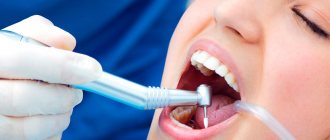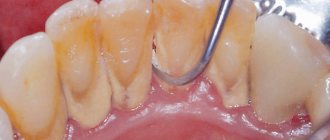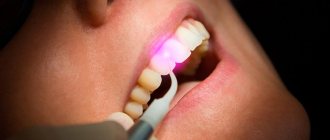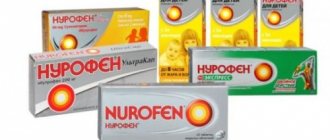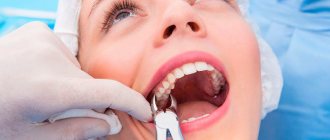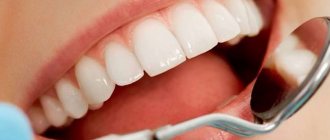In modern dentistry, when treating caries at different stages, doctors often install light fillings. This is explained by the advantages of photopolymer composite material compared to the traditional composition. The light filling looks natural (often the color does not differ from tooth enamel), is resistant to stress, and less toxic. In addition, its installation is easy and does not take much time.
To maintain the results obtained by the dentist, you must follow several recommendations. And then the material will not peel off and collapse.
Many patients are interested in the question of how long they should not eat or drink after the doctor fills a tooth with composite material. And in general, are there any restrictions? Now we will tell you everything in detail.
What is a light seal?
The photopolymer composite material that the dentist uses consists of a mixture of resins, silanes and filler.
It hardens when exposed to ultraviolet radiation, so when filling a tooth, the doctor uses a special lamp that creates waves with a length of 450 Nm in the blue spectrum. For a high-quality result, he applies the composite material layer by layer, exposing each layer to light. At this stage, primary polymerization occurs. Then, within 24 hours, the chemical bonds stabilize and the filling finally hardens.
In this regard, the doctor gives certain recommendations, compliance with which guarantees the durability of the material - the filling lasts 5 years or more.
Why is it important to follow your dentist's recommendations?
Modern methods and technologies for caries treatment, which are used by doctors in dental clinics, help quickly, painlessly and effectively solve the problem of dental caries. If the doctor correctly selected the filling material and installed the filling in compliance with all technological details, the restored tooth can serve the patient for many years.
But, in addition to the professional work of the doctor and the quality of materials, the durability of the filling is affected by compliance with the dentist’s recommendations immediately after caries treatment.
One of the first questions to ask your doctor is when you can drink water and have lunch or dinner after dental treatment.
Advantages of photopolymer material
This differs from other types of composite materials:
- The ability to control the hardening process. The doctor fills the tooth without haste, applying layers of material as carefully as possible. The composition is plastic, hardens only when exposed to an ultraviolet lamp.
- Safety for the patient's health. Photopolymer material is characterized by low toxicity, so it is used even in pediatric dentistry.
- The ability to create a filling of the desired shade. She won't stand out.
- Durability. It is due to good adhesion to hard tissues. Typically, the service life of a photopolymer filling is at least 5 years. With careful handling and high-quality teeth cleaning, its service life increases.
- Ease of finishing. The composite can be polished well, so the filling does not create discomfort - it will not scratch the mucous membrane of the tongue and cheeks.
An experienced dentist can easily give the crown the desired shape, so the filled tooth looks natural.
Contraindications
In rare cases, filling leads to complications. A person experiences pain even after 3 days from the date of the intervention. Unpleasant sensations can be sharp and shooting, they cannot be eliminated with the help of analgesics. This happens when there is inflammation of adjacent tissues, incomplete removal of the nerve, or poor material. More often, complications are encountered by those people who did not take into account contraindications. In some cases, the procedure cannot be performed, as it can only worsen the situation.
Main contraindications:
- The tooth cannot be restored, so it will have to be removed.
- An x-ray revealed internal root resorption.
- There is severe resorption, which affects more than a third of the root.
- There are carious perforations in the bottom of the chamber.
- Bone loss in which there is loss of periodontal attachment.
- There is a follicular or odontogenic cyst.
The doctor will tell the person whether there are contraindications for the procedure.
Types of light seals
The dentist chooses a photopolymer material depending on the location of the tooth and the task at hand - will it be caries therapy or the elimination of a non-carious defect on a unit.
There are 3 types of material:
- consisting of large particles - preferable for chewing molars, such a filling will be resistant to abrasion;
- consisting of microparticles - relevant in the case of treating caries on the front teeth and restoring the aesthetics of the units;
- nanocomposite - durable, reliable, aesthetic, but has a higher cost.
Before deciding to install a light filling, the doctor will definitely evaluate the location of the caries. If the lesion is in a hard-to-reach place, you will have to choose another material due to the impossibility of high-quality polymerization.
Care after filling - nuances
Brush your teeth regularly
- Plaque accumulates quickly. Use the entire hygienic “arsenal”: brushes, brushes, rinses. This slightly increases the cost, but treating caries is still more expensive.
Be gentle
- modern polymers, although durable, can crack and collapse from regular hard cleaning, and even more so from the use of abrasives like soda.
Visit your doctor every six months
- installing a filling, even the most high-quality and expensive, weakens natural protection. To check whether caries has developed under the structure, come for professional cleaning and do caries prevention.
When can a light seal be placed?
The photopolymer composition is considered universal, therefore it is widely used in dentistry. There are a large number of pathologies for which the dentist prefers this composite, including:
- caries;
- erosion and necrosis of enamel;
- fluorosis;
- wedge-shaped defect;
- pulpitis and periodontitis (light filling is placed at the final stage of disease treatment);
- dental injuries and chipped enamel;
- pathological abrasion of units (a photopolymer filling is installed for temporary restoration of the tubercles).
In addition, the dentist uses this filling material to give the stump the required size and shape before prosthetics with fixed dentures. Thanks to a wide palette of shades and good strength after hardening, the photopolymer composition is suitable for any units in the series; it is also chosen for aesthetic restoration.
Temporary
Installing a temporary filling is a fairly common procedure. To make such a substance, liquid and special powder are used. Its composition will determine the drying time of the lining. Often, after removing the nerve, before filling the canals of the masticatory organs, the cavity is closed using a temporary structure. As soon as the anesthesia wears off, you can immediately start eating. Eliminate solid foods from the menu for a day to prevent the pad from crumbling.
Since the temporary filling does not reach complete hardening immediately, especially its internal part, patients are advised to eat after two to three hours. At first, you should not eat nuts, crackers, or chew chewing gum. Although such an overlay is installed for a short time, then removed and replaced with a permanent substance, it also needs to be taken care of. This will help prevent cracking and other types of damage. The best option is to ask the dentist in advance what substances the veneer is made of. Then it will be clear how long you should wait before eating.
How is the filling installed?
First, the doctor prepares the tooth for restoration - removes pathological tissue and forms a cavity, removing softened dentin and enamel. This ensures the durability of the filling. If the tooth is severely damaged, the dentist removes the nerve, installs a pin, and only then proceeds to filling the canals and forming a crown.
Before starting work with photopolymer material, he etches the cavity with acid to clean the walls of sawdust and other foreign particles formed during drilling of the affected tissue. This manipulation helps to open the dentinal tubules, which improve the fixation of the filling.
After this, the doctor applies an adhesive material, which acts as a connecting link between the tooth and the photopolymer composition. After illuminating it, the doctor applies the filling material in small portions in layers, carefully pressing it to the bottom and walls of the cavity. Each layer is exposed to ultraviolet light. When the dentist completes the modeling, he grinds and polishes the surface of the filling.
Filling services in our clinic
Our clinic in the center of Moscow offers high-quality dental filling services. Experienced dentists with extensive experience approach each client individually and do everything to ensure that the procedure is comfortable. Doctors will choose the type of filling needed after examining the oral cavity. Only high-quality and modern materials are used, which have a long service life.
We perform root fillings without pain or any discomfort. If necessary, we will restore the primary incisors so that they do not further deteriorate and fall out prematurely.
Dentists guarantee a high-quality result - the filling will not differ in appearance from the tooth. It will last for a maximum period, which is determined by the selected material. There are both budget options and expensive ones. The client will be able to choose a specific filling service based on personal needs.
To eat or not to eat: what recommendations does the doctor give?
After installing the light seal, you can eat and drink immediately. This is its significant advantage over a cement filling. But in cases where dental procedures were performed under local anesthesia, the doctor recommends refraining from eating for 1-2 hours. This is due to the fact that due to decreased sensitivity, the patient may injure the mucous membrane of the tongue or cheeks while chewing food. The damage will cause discomfort.
Since the material will finally harden after 24 hours, you should avoid hard foods (nuts, apples, etc.). It is better to give preference to soft food. On the first day after filling, it is advisable to quit smoking. This is due to the fact that the material may turn yellow and the healing of tissues that have been exposed to dental treatment may deteriorate.
To maintain the aesthetic appearance of the filling, for 2-3 days you should not consume foods and drinks that can stain the photopolymer material. Among them:
- coffee;
- red wine;
- pomegranate, cherry and other freshly squeezed juices;
- carrot;
- beets (including as part of first courses, salads, etc.);
- blueberry;
- chocolate;
- carbonated drinks containing dyes.
You should drink natural juices with caution, even if, in your opinion, they will not stain the filling (it is better to use a straw), strong black tea, and eat strawberries and cherries. It is worth limiting the amount of sweet and starchy foods in your diet. It is advisable to avoid the consumption of cold and hot foods, as well as their simultaneous intake. Temperature contrast can negatively affect both the filling itself and the tooth tissues.
Let us draw your attention to one nuance: some dentists still advise refraining from eating for 2 hours and drinking drinks for an hour in order to reduce the risk of complications after filling a unit.
A temporary filling has been installed: how much can you eat?
Sometimes, for pulpitis or advanced forms of caries, treatment is carried out in two or more visits. At the first appointment, the doctor opens the tooth, removes the affected tissue and, if necessary, puts a medicinal product that should remain in the tooth cavity for several days. To prevent bacteria and contaminants from entering the cavity during this time, the doctor closes it with a temporary filling. The peculiarity of such fillings is that they are made of a more fragile material than permanent ones.
Therefore, when it comes to a temporary filling, the dentist usually gives the following recommendations:
- do not eat for about two hours (the exact time depends on the chosen material);
- Until the temporary one is replaced with a permanent one, avoid solid foods that can cause the filling to fall out - crackers, nuts, etc.
Check yourself: when to see a doctor
If a tooth hurts 2-3 days after the filling is placed, and the pain noticeably intensifies when pressed at night, this may indicate a relapse of caries and damage to the dental nerve. If black spots are visible under the filling several months after treatment, the filling interferes with the closure of the jaws or there is prolonged pain when pressing on the tooth. Do not ignore these symptoms and do not be afraid - this is a reason to contact your attending physician - all work must be carried out within the framework of the guarantee of the medical institution. Timely treatment is the key to the health of your teeth!
What to do to make dental anesthesia go away faster
Some patients are interested in: what can be done to make dental anesthesia go faster? Unfortunately, we cannot significantly influence the duration of pain relief after treatment or removal. Experts only recommend waiting a certain period of time. You can check with your attending physician how long the freezing will last in your particular case, since he knows exactly what drug he administered and in what quantity.
It is believed that a warm compress will help speed up the frostbite process after a dental appointment. It dilates blood vessels and promotes the removal of anesthetic. But it is contraindicated in the presence of tissue inflammation, diseases of the oral cavity, and can cause complications. Therefore, you cannot apply a compress without a doctor’s recommendation.
Here are some recommendations on what to do to make jaw numbness go away faster:
- Drink a warm drink (tea, juice) that will start your metabolism;
- Have a small meal or snack;
- Get enough rest;
- Avoid physical activity and going to the gym;
- Refrain from bad habits (smoking, drinking alcohol).
How to cope with not eating after 6 pm?
Finding a new hobby
Eating at night is often mindless, a result of boredom during other activities such as watching TV. If you engage in other hobbies, you are less likely to overeat. But you need to think about your hobby in advance, since everything you need for it should already be at hand. You need to choose activities that keep your hands busy. For example, you can give preference to knitting, embroidery or sewing, try to assemble a puzzle of 1000 puzzles or more, buy a sketchbook or a ready-made painting for coloring by numbers, in the end - just start solving scanword puzzles or performing various tasks. Anything to keep your hands focused on something other than eating. On the subject: Nordic walking for weight loss The mind also needs to be occupied with something so that it does not think about whether it is possible to eat after 18.00 without harm. Eating at night can sometimes be a result of emotional stress, so focusing on something else will help relieve your hunger. Many simple games are available online where you can compete with other players. Even playing cards with your family can help take your mind off things.
Not a day without fun
Often people who relax at the end of the day with food did not experience joy or pleasure throughout the day, and did not give their body rest. If this is the case, you can try to fix it. In this way, the person will be less focused on eating at night as a primary form of emotional release. But there is another factor - going with friends to cafes, bowling alleys, bars and other establishments can again lead to a common feast. And it’s very difficult to cope when everyone around you is eating. Therefore, you need to plan your schedule in advance.
Interest club
Meeting new people and getting involved in your community can improve your overall happiness. This means less emphasis will be placed on eating after 6pm as a form of relaxation and rest. You can find a suitable company through forums, social networks, etc. Separately, there are support groups for people who are trying to get rid of negative eating habits. Sometimes the moral component helps much more than other advice or recommendations. Therefore, you should not be shy to talk about your desire to overcome yourself, but it is better to agree to support. This is where they will tell you why you can’t eat after 6 pm and give you practical advice.
Teeth cleaning
You need to brush your teeth not only in the morning and evening, but also after lunch. Brushing your teeth can be a great way to combat the urge to eat at inopportune times. For example, the first reason could be that the brain enjoys a clean mouth and does not want to keep it fresh for as long as possible. Secondly, toothpaste with menthol dulls appetite and gives a feeling of fullness. Therefore, the search for what you can eat after 6 pm stops. Toothpaste and mouthwash change the taste of foods. Popular salty and sweet snacks will not seem so appetizing after brushing your teeth with mint paste. An alternative is to buy sugar-free mint-flavored chewing gum. As soon as you feel the urge to sit down, you can immediately start chewing gum. This method allows you to perfectly combat emotional hunger, when in reality your stomach is already full. But you need to do this only for the first time, until your stomach gets used to the schedule. Then you can also stop chewing gum frequently. Another option is fresh breath spray or tick-tock, other sweets that do not contain sugars.
Healthy and restful sleep
Often, a disordered sleep schedule can create a disordered eating schedule. Changing your sleep schedule can help combat this problem. Violation of the regime can easily lead to a lack of breakfast. The most common example: you need to be at work at 9 o’clock, but the person went to bed at about 2 am. Naturally, he will want to sleep longer in the morning, and not get up half an hour earlier and have breakfast. And skipping a morning meal is the first sign that in the evening the question will arise whether you can eat after 6. You need to go to bed and wake up at approximately the same time every day and sleep 7-9 hours a day. The body and mind will adapt to the routine, and after 21 days, sleepiness will occur at the same time as wakefulness. The main thing is not to give yourself another “five minutes.” They will interfere with the restoration of the schedule and, at the same time, will have no value for sleep.
Support from loved ones
If eating after 6 has already become a permanent habit, then you should understand the fact that coping with it will not be easy at all. This will be overwhelming at first, and reaching out to friends and family for support can help you cope. For example, they can help control your eating schedule, make sure that treats are not available in the evening, or help take your mind off negative thoughts. You can also come up with a regular time together. Loved ones who live under the same roof with a person can help restore a sleep schedule.
How long should it take to freeze?
How long does anesthesia last after tooth extraction? The duration of the effect depends on several factors:
- The type and amount of pain medication administered;
- Type of anesthesia, injection depth, injection site;
- The presence of a vasoconstrictor in the drug (substances that constrict blood vessels and prolong pain relief);
- Human weight, individual parameters;
- Features of metabolism;
- The presence of chronic diseases of the urinary system.
Conduction anesthesia lasts 2-3 hours on the upper jaw and 3-5 hours on the lower jaw. Therefore, the pain relief effect may persist for several hours after visiting the doctor. Other types of local anesthesia have a shorter period of action - from 15 minutes to 2 hours.
What to do if the numbness does not go away?
There is no need to be afraid of prolonged tissue numbness; after a couple of hours, sensitivity will definitely return. If numbness in your teeth, tongue, jaw, or nose after anesthesia does not go away by the end of the day, you should call your doctor and report the situation. In rare cases, complications of anesthesia occur in the form of paresis and paresthesia - disruption of tissue innervation. They appear when a nerve is accidentally injured by a needle. In this case, you need to visit a doctor who will prescribe treatment for the pathology. When the anesthesia of the tooth wears off, discomfort and unpleasant sensations may appear.
In most cases, tissue anesthesia passes without a trace, so if there are indications for anesthesia, there is no need to be afraid to perform it. If you have had an unpleasant experience with pain relief or need emergency treatment under anesthesia, you should simply tell your dentist about it. The doctor will definitely take into account your wishes and will be able to control the amount of the drug and the duration of its action.
If your tooth hurts after getting a filling
Minor pain may persist for several days or even a couple of weeks, which is explained by overheating of the tissue due to the use of boron, and therefore the preparation is usually carried out with cooling with water. In some situations, for example, with deep caries or when treating front teeth, increased sensitivity can persist even for several months. But in such a situation, you should still consult a doctor for an x-ray to make sure that there is no infected tissue left under the filling and that inflammation has not affected the nerve.
How to properly perform hygiene procedures
After treatment, brush the filled tooth carefully, applying minimal pressure to it. Do not use rinses containing abrasive substances and alcohol, which can increase the plasticity of the material - this will lead to a change in the shape of the filling. Also, do not use overly hard brushes - they can leave microcracks in the material, which will not have the best effect on the durability of the filling.
In general, you should take care of teeth with fillings in a completely standard way:
- daily brushing of teeth twice a day - in the morning after breakfast and in the evening after all meals, after - rinsing the mouth with water and rinse,
- To clean the area of filled teeth after eating, it is better to replace dental floss with an irrigator. If you floss (thread) carelessly, you can touch the installed filling, especially if there are thin edges of the tooth, which will lead to its chipping or loss.
Myth 5. To lose weight, you need to use sweeteners.
Not true
I.P.: - There is a sweetener made from plant materials - stevia (honey grass). An extract is extracted from it, which is 200 times sweeter than sugar. Stevia does not increase blood sugar levels, thereby not triggering the release of insulin. Whereas it is the increased level of insulin that contributes to weight gain, and fat is deposited mainly on the abdomen.
However, a healthy person still does not need to consume foods for diabetics (and a sweetener is one of them). To lose weight, I would recommend a balanced diet excluding the consumption of simple carbohydrates: chocolate, cream products, pastries, pies. Also exclude glazed cheese curds, curd mass, baked goods (products made from puff pastry and shortcrust pastry), halva, and ice cream. For those who cannot live without sweets, you can eat dried fruits, honey, sometimes marshmallows, and marshmallows (in reasonable quantities).
Myth 7. Vitamins should only be taken in winter; fresh vegetables and fruits are enough in summer.
Not true
I.P.: - According to statistics from the Institute of Nutrition of the Russian Academy of Medical Sciences, vitamin C deficiency occurs in 100% of the Russian population, deficiency of B vitamins - in 70%, deficiency of beta-carotene (precursor of vitamin A) - in 60%. So everyone needs vitamins, and even more so in order to prepare for vacation and sunbathing.
To receive a sufficient dose of vitamins, a modern person needs to eat properly and take additional vitamin complexes. Beta-carotene, B vitamins, especially PP and B12, help strengthen the protective upper layer of the skin; vegetables and fruits, fish, cottage cheese, buckwheat, almonds, and grain bread are rich in them. Sun rays reduce the amount of vitamin C in the skin, so try to eat currants, citrus fruits, kiwi, bell peppers, herbs, tomatoes, etc. more often.
However, technological progress, unfortunately, has led to an increase in the share of refined and canned food products that have less vitamin value. For example, when making high-grade flour, up to 80-90% of all vitamins are lost, so it is better to eat dark or grain varieties of bread. In general, every adult should take advantage of any available vitamin-mineral complex. The main thing is to focus on meeting the daily needs of the body.
